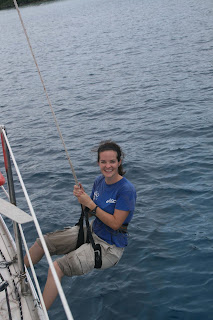
We left the Vav’au Group at 6 in the morning October 12 with five other boats, Stray Kitty, Anthem, Imagine, Nikita and Jackster. It was flat calm, but as predicted the winds came up from the northeast, giving us a 60 mile downwind ride to the next Tongan islands, the Ha’apai Group.
Like the Tuomotos in French Polynesia, the Ha’apai Islands are also coral atolls, rich with tropical life. We hoisted our spinnaker and enjoyed the sail to the first Ha’apai island, Ofolanga. Here's a fun picture of Kamaya with Jackster -- don't worry we didn't collide.

At Uoleva Island, I can see Tofua, an active volcano. Sometimes the volcano spews red flames into the air, but today, October 20th, it is calm. Here, in this stretch of the Pacific Ocean, the famous mutiny of the Bounty occurred.
It happened in the wee hours of the morning on April 28, 1789, when Fletcher Christian abruptly woke up Captain William Bligh. The sun had yet to rise. Christian seized Bligh and at gunpoint forced Bligh and 18 loyal men, off of the bigger 215 ton ship and into the 23-foot launch boat.
Bligh took his men to Tofoa and stayed there in a cave. At first the Tongans were friendly, welcoming them with coconuts and breadfruit. But then relations changed. Perhaps the Tongans noticed Bligh’s weakness or perhaps they wanted more from Bligh. Suddenly, Bligh and his men rushed out of the cave and as they were getting back into their small boat, the Tofuans threw stones at them. One man died, but the others escaped. This sour experience with locals shaped Bligh’s plans; he chose to go to the island of Timor, a Dutch colony, and not to trust anyone along the way.
If only we were here 211 years ago then we could have saved Captain Bligh from his grueling 41 day, 3618 mile journey. But then again, if we were here 211 years ago, people might not have been so welcoming and Captain Bligh might not have been so nice either.
Indeed, time often changes things as it has here in Tonga. Forty years after Bligh’s bad experience, the Wesleyan (Methodist) missionaries arrived in Tonga, converted the chief of the Ha’apai and crowned him King George Topou I. The country transformed, after a big battle, from a cannibalistic tribal society into a religious one. The missionaries even persuaded people to cover up – they used to wear woven leaf skirts called ta’ovalas with nothing underneath; but now they wear their traditional mats over their clothes.
Most villages that we’ve visited in Tonga have at least four churches, including the The Church of Tonga, The Mormon Church, The Free Wesleyan Church, and the Catholic Church. I asked Blair Gilbert, a peace corps volunteer from Texas stationed in the remote island of Ha’ano, why the Tongans so heartily embrace Christianity, and she responded that the Tongans like the routine, community and beliefs that accompany being a member of the church. She said that often people attend church every day and three times on Sunday.
“It gives them structure and something to do,” she told us during our visit to the school where she teaches English. Blair came to our boat and tried halyard swinging, a first for her.

Sailing in the Ha’apai Group requires keen awareness of coral reefs as they are all over, spectacular, almost alien looking,

with so many different shapes and sizes...

And these beautiful reefs can also be dangerous for sailboats. Earlier this month, a French boat, La Tortue, anchored in the small island of Kelefesia. In the late afternoon, their anchor drug and, to make matters worse, their engine wasn’t working so they couldn’t motor away from the reef. They set two more anchors, but it didn’t work and sadly the fero-cement boat ended up on the reef with a big hole in it. It eventually sank and our friends on Tyee, Jangada and Zephrus went to the island to help salvage the boat.
Many of us sailors are reflecting on the recent loss of La Tortue, trying to learn lessons from the tragedy. We wonder why they left the main island of Nuku’alofa with strong 25-30 knot winds; we wonder why they decided to go into Kelefesia, a place where guidebooks recommend going only in calm winds. We know they went down to Nuku’alofa to pick up friends from France who had a limited amount of time. Perhaps being on a schedule threw them off in the first place and set the disaster in motion. It’s amazing how fast things can spiral out of control.
Talking about schedules, it’s time for us to get ready to leave the tropics before cyclone season. Yesterday, October 28th, we had an intense sail to Nufu’alofa with 25 to 30 knot winds and rain. I'm hoping that wasn't a preview of our next 1,025 mile passage to New Zealand.

No comments:
Post a Comment